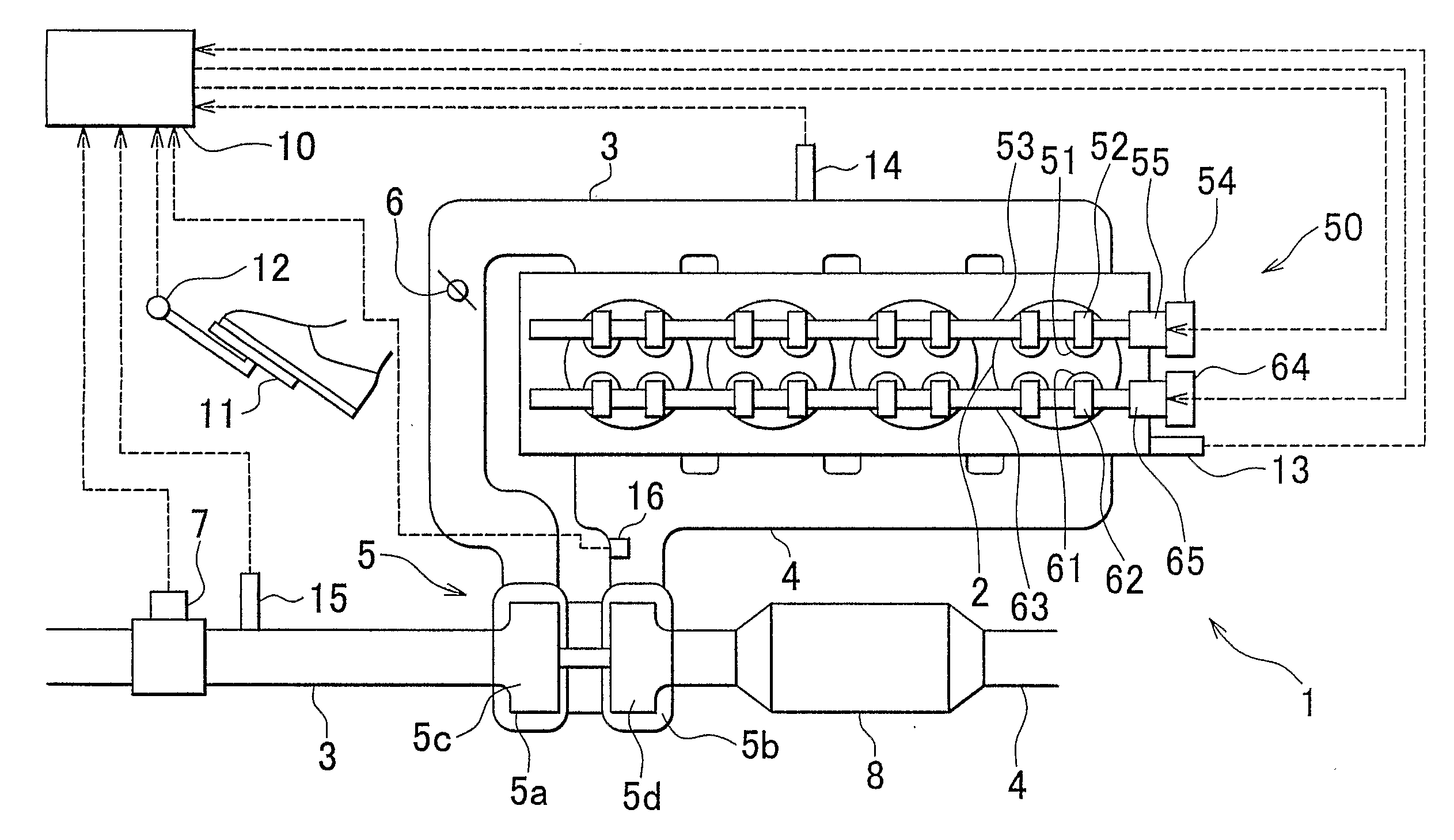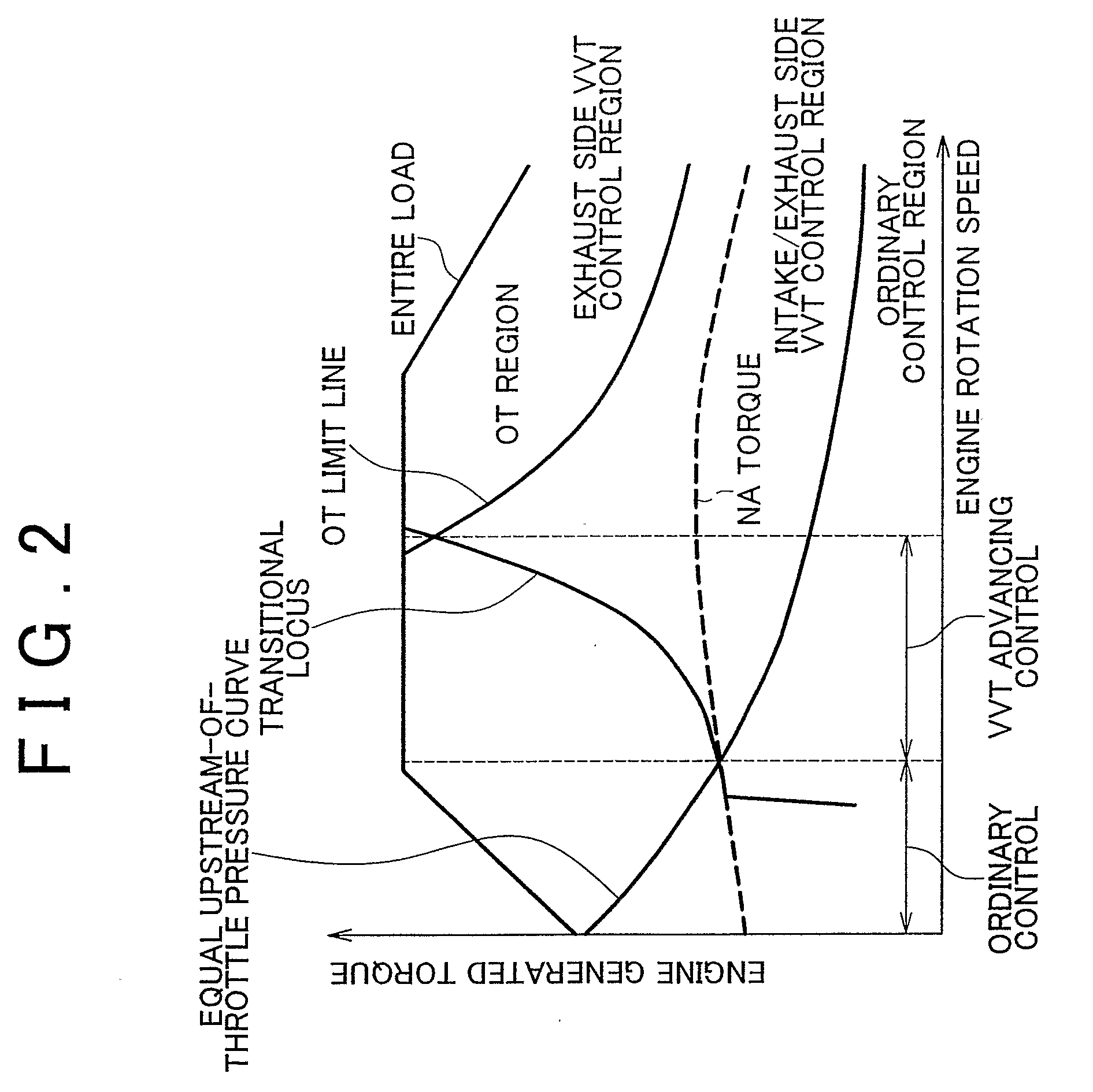[0010]By performing the EGR, a portion of the high-temperature exhaust generated in a cylinder in the present cycle can be taken into the cylinder in the next and later cycles. Specifically, a portion of the energy generated in the present cycle can be used in the next and later cycles. This increases the total amount of energy in the next and later cycles. Therefore, since the degree of retardation of the
ignition timing for increasing the energy of exhaust can be reduced, decline of the engine generated torque can be restrained. Thus, it is possible to increase the energy of exhaust while restraining the decline of the engine generated torque. Hence, the responsiveness of boost
pressure rise can be enhanced, and deterioration of the drivability can be restrained.
[0012]The internal EGR is performed by once causing burned gas to flow into the exhaust passageway or the intake passageway and then refluxing it through the same passageway and introducing it into the cylinder, or by increasing the burned gas remaining in the cylinder. For example, the internal EGR is performed by sucking the burned gas blown back in the intake passageway into the cylinder again, or by refluxing the burned gas discharged into the exhaust passageway and sucking it into the cylinder, or by reducing the amount of burned gas discharged from the cylinder and thereby increasing the amount of burned gas remaining in the cylinder. The internal EGR can be performed, for example, by the variable valve mechanism altering the opening and closure timings of the
exhaust valve. By adjusting the opening timing, the closure timing, the lift amount and the operation angle of the
exhaust valve, the variable valve mechanism adjusts the amount of
fresh air sucked into the cylinder of the internal
combustion engine, the EGR amount, the remaining gas amount (internal EGR amount), the pump loss, etc., so that the operation state of the internal
combustion engine is altered. For example, if the pressure in the intake passageway is lower than the pressure in the cylinder or the exhaust passageway, the opening timing of the intake valve is advanced so as to expand the valve overlap during which the intake valve and the
exhaust valve are simultaneously open, so that the amount of burned gas blown back to the side of the intake passageway increases. Then, the burned gas blown back into the intake passageway is sucked into the cylinder in the next intake
stroke. Therefore, the burned gas in the cylinder in the next cycle increases. Besides, if the closure timing of the exhaust valve is made earlier than the exhaust
top dead center, the amount of burned gas blown back to the intake passageway side, and this burned gas is sucked into the cylinder in the intake
stroke. Therefore, the burned gas that remains in the cylinder increases. Furthermore, if the closure timing of the exhaust valve is made later than the exhaust
top dead center, the burned gas once discharged into the exhaust passageway is refluxed into the cylinder in the intake
stroke. Therefore, the burned gas that remains in the cylinder increases. In this manner, the internal EGR amount can be increased. Since the temperature of the internal EGR gas is higher than the temperature of the external EGR gas conveyed via an EGR passageway, the energy in the cylinder can be increased by increasing the proportion of the internal EGR gas in the cylinder.
[0014]The pressure of intake is the pressure of the air taken into the cylinder. If a
throttle is provided in the intake passageway, the pressure of intake is the pressure downstream of the
throttle. If the pressure of intake is, for example, lower than the pressure upstream of the
throttle or the
atmospheric pressure, the value of rise of the boost pressure for the value of rise of the
turbine rotation speed is small; therefore, even if the exhaust energy is increased, its effect of enhancing the responsiveness of boost
pressure rise is small. Besides, if the pressure of intake is low, the internal
combustion engine is often operated with
low load. In this case, since the temperature of the internal EGR gas is low, execution of the internal EGR will achieve only a small increase in energy in the next and later cycles. On the other hand, the prohibition of the EGR will lead to an increased engine generated torque, so that the intake air amount can be increased by increasing the engine rotation speed. Therefore, the responsiveness of boost pressure rise can be improved. Incidentally, the aforementioned “predetermined value” is an upper
limit value of the
intake pressure at which performance of the internal EGR will have only a small effect, and is, for example, the pressure upstream of the throttle or the
atmospheric pressure.
[0016]If the opening timing of the intake valve is advanced, the amount of burned gas that flows into the intake passageway becomes larger, so that the internal EGR gas amount increases. This increases the energy that is added in the next and later cycles. However, if the opening timing of the intake valve is excessively advanced, the responsiveness of boost pressure declines due to a declined torque generated in the present cycle, and the decline in the responsiveness surpasses the rise in the responsiveness of boost pressure obtained in the next and later cycles. In that case, if the amount of advancement of the opening timing of the intake valve is restricted, the decline of the generated torque can be restrained. Furthermore, by maximizing the internal EGR gas amount while the generated torque remains within the range, the responsiveness of boost pressure rise can be improved. Incidentally, the “predetermined range” may be a range such that in the next and later cycles, the rise in the boost pressure caused by an increase in the energy of exhaust can surpass the decline in the boost pressure caused by a decrease in the engine generated torque. Specifically, as long as the engine generated torque is within the range, decline of the engine generated torque in the next and later cycles can be restrained even if the engine generated torque in the present cycle declines due to advancement of the opening timing of the intake valve. Furthermore, by combining retardation of the opening timing of the exhaust valve, the engine generated torque can be increased.
[0018]Since an increase of the internal EGR causes slow combustion, the ignition timing is advanced so as to increase the engine generated torque in the related art. Besides, if the EGR gas amount increases, the temperature inside the cylinder rises, so that knocking becomes likely to occur. If knocking occurs, the ignition timing is retarded in the related art. On the other hand, if advancement of the ignition timing is prohibited when there is no risk of occurrence of knocking, the engine generated torque decreases but the exhaust temperature can be correspondingly raised. Therefore, the exhaust energy can be increased, so that the responsiveness of the turbocharger can be bettered.
[0021]For example, if the temperature of the catalyst becomes excessively high, degradation of the catalyst progresses, or the exhaust purification capability of the catalyst declines. Besides, for example, if the temperature of the turbocharger becomes excessively high, there is a risk of damaging the turbocharger. Therefore, for example, if the temperature of the turbocharger and / or the exhaust purification catalyst becomes high to a certain extent, the exhaust temperature cannot be allowed to rise any more; therefore, it becomes difficult to increase the internal EGR. In that case, if the opening timing of the exhaust valve is retarded, the energy that pushes down the
piston becomes larger in the energy of the burned gas, so that the engine generated torque increases. Besides, if the opening timing of the intake valve is retarded, the period during which the intake valve and the exhaust valve are both open lengthens. If the exhaust temperature is high, the boost pressure is also high, so that during the overlap period, air is blown by from the intake passageway to the exhaust passageway. This changes the timing of exhaust pulsation so as to decline the
back pressure occurring when the intake valve and the exhaust valve are both in the open valve state. As a result, the speed of exhaust near the end of the exhaust stroke can be raised, so that
dynamic energy can be given to the
turbine, and the responsiveness of boost pressure rise can be enhanced. Besides, by avoiding advancement of the opening timing of the intake valve, increase of the internal EGR can be restrained, so that rise in the exhaust temperature can be restrained Incidentally, the “predetermined temperature” is a
lower limit value of the temperature at which there is a risk of decline in the performance of a member provided in the exhaust passageway of the internal combustion engine or a member constituting the internal combustion engine, or a risk of damage of such a member.
 Login to View More
Login to View More  Login to View More
Login to View More 


